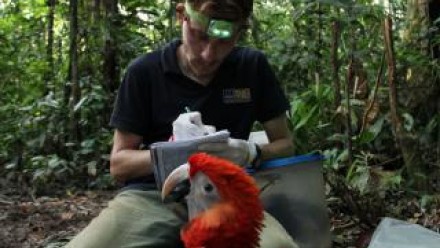Using artificial nests to assist and study Macaw Parrots in lowland Peru
When a massive road project connected the ports of Brazil to the shipping docks of Peru (2011), spanning the Sth American continent, conservationists predicted widespread impacts on wildlife living along the route that stretches almost 5,500 kilometers. Roads are well-documented sources of habitat fragmentation, interfering with available habitat access for terrestrial and tree-dwelling species. However, it wasn’t clear whether or not birds would be able to fly over these barriers. George Olah, a PhD Student from the ANU Fenner School of Environment and Society and co-supervised by Rod Peakall at The ANU Research School of Biology, set out to see if they could.
Olah was already studying the genetics of scarlet macaws (Ara macao) in a remote area of southeastern Peru when the Transoceanic Highway was built through the middle of his research area. He realized that the forensic genetics techniques he was using to learn more about the local macaw population might also uncover evidence of the road’s impact on the birds (details at: Feather forensics: scientist uses genes to track macaws, aid bird conservation).
Parrots (Psittacidae) have some of the most threatened species of any bird family in the world. Most parrots are obligate secondary cavity nesters, and can be limited in their breeding success by the availability and quality of nest hollows. However, nesting opportunities for parrots can be increased by provision of artificial nest boxes. A recent publication in the Journal for Nature Conservation 'Nest site selection and efficacy of artificial nests for breeding success of Scarlet Macaws Ara macao macao in lowland Peru' aimed to determine the nesting requirements and reproductive success of breeding macaws; and compare the efficacy of two types of artificial nests and natural nest cavities. The data showed a high rate of reoccupation of successful nests in consecutive years and that artificial and natural nests had very similar reproductive parameters. The results indicated that artificial nest types can be used by conservation managers seeking to assist macaw populations where nest hollows are in short supply, and that artificial nests can contribute important data to natural history studies of species where access to natural nests is limited.
George and his fellow researchers are seeking funding through crowd funding to make a 26-minute documentary of macaw conservation research in the rainforest of Peru.













